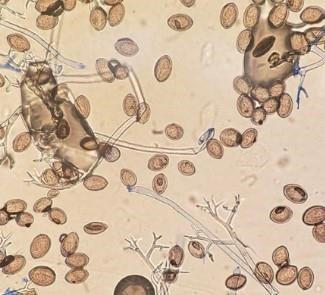I believe that our delayed downy mildew development in the state is the result of the high temperatures and dry conditions we have experienced. Since the cucurbit downy mildew pathogen (Pseudoperonospora cubensis) prefers cooler temperatures, the current temperatures which are now more moderate, along with the recent rains, has set the stage for a rapid escalation of the disease in the state if fungicide sprays are delayed.
Suspect samples should be submitted for a diagnosis. See instructions on how to submit samples.

Photo 5. A closeup of the underside of the leaf with the dark mold of the downy mildew pathogen. Photo by David Perla, MSU.

Photo 6. Under the microscope, the individual lemon-shaped sporangia (spores) can be seen. Photo by David Perla, MSU.
It is very important that cucumber growers use proven downy mildew fungicides (shown below in alphabetical order). These fungicides were effective in our 2022 research field plots and include:
- Elumin + chlorothalonil or mancozeb
- Omega (Orbus) + chlorothalonil or mancozeb
- *Orondis Opti (Chlorothalonil is part of the premix, additional chlorothalonil is suggested. See label for maximum chlorothalonil rates.)
- Previcur Flex + chlorothalonil or mancozeb
- *Ranman + chlorothalonil or mancozeb
- Zampro + chlorothalonil or mancozeb
* Across many years of field tests, Orondis Opti and Ranman have been the leading fungicides in cucurbit downy mildew control in Michigan and would be especially recommended given the positive downy mildew air samples detected across the state and the positive disease sample from Saginaw County.
Fungicides should be alternated so that resistance of the pathogen to the fungicide’s active ingredient does not develop. It is important that the fungicides be applied prior to plant infection. Waiting until downy mildew has developed in the field prior to applying fungicides can lead to control failure and pathogen resistance. In many parts of the state, the second pickling cucumber crop has now been or soon will be planted. Downy mildew can infect the cotyledons of cucumbers and has been observed in previous years for late season plantings.
Source : msu.edu